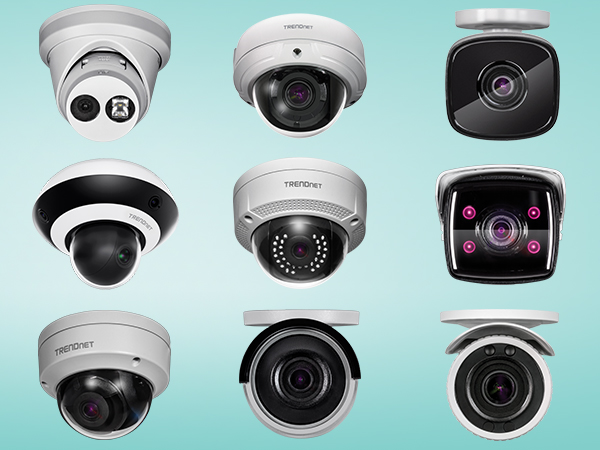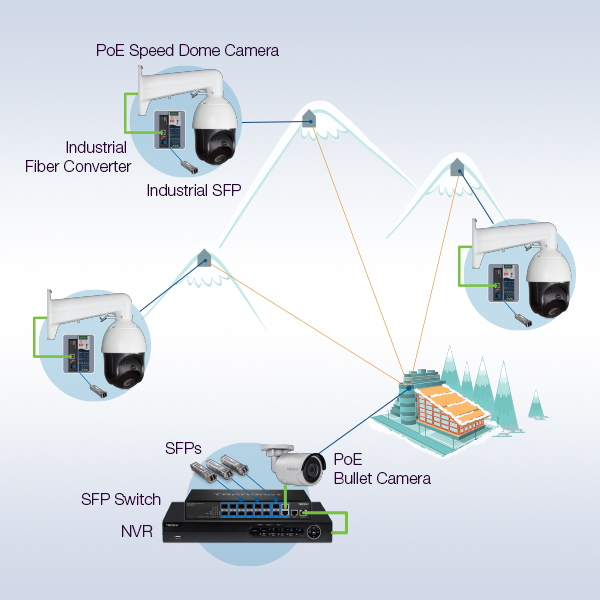PoE Cameras Guide for Beginners
Choosing the Best PoE Camera for You
February 2021

What is PoE? What are PoE Surveillance Cameras?
Power over Ethernet or PoE technology allows you to use a single cable for both data and power. Without PoE, you would need to run two separate cables, one for a network connection and one for power. Running multiple cables increases both infrastructure costs and labor costs. The ability to run one cable essentially kills two birds with one stone.
PoE surveillance cameras are IP cameras (or also called network cameras) that utilize PoE technology, delivering both data and power over a single cable. Note that while all PoE cameras are IP cameras, not all IP cameras are PoE cameras. Unlike traditional analog CCTV cameras, IP cameras (and PoE cameras) can be used as a standalone device; to connect analog cameras to the network, these cameras require a DVR to convert the analog signal to IP.
PoE Terms You Need to Know
PoE Type: Amount of PoE power that can be delivered per port
PoE Class: Amount of PoE power that may be reserved on a PoE switch for a PoE device
PoE Budget: Maximum amount of power a PoE device will require
Knowing the type and class of powered devices will help you determine which type of network switch you’ll need, and how much power you’ll need. Note that some devices use “passive PoE;” these devices use a non-standard technology and will likely require a proprietary PoE injector to connect with your network. Since passive PoE is not an industry standard, there may be incompatibility issues if not installed correctly. For more information on IEEE PoE Standards and PoE Budgets, read ‘How PoE Device Class Affects Your PoE Budget.’
What are the benefits to PoE and PoE Surveillance Cameras?
Delivering both data and power over a single cable helps to save on unnecessary infrastructure costs and reduce total installation time. Setting up two sets of lines to go to the same location adds to cabling costs and labor costs, including the cost of the cables and the time it takes to complete the wiring. Additionally, with PoE surveillance cameras, you won’t need to worry about a nearby power outlet to power the camera, standard PoE can be extended from the power source for up to 100m (about 328 ft.).
In terms of resolution, analog cameras are no match to IP cameras. Currently, the highest resolution analog camera available is 1080p. A 1080p resolution is still considered HD resolution, but if you’re looking for higher quality video, such as 4K UHD resolution, you’ll need to use IP cameras.

PoE Camera Form Factors
PoE surveillance cameras come in many shapes and form factors. The most common form factors used are bullet, dome, turret, PTZ, multi-sensor, and speed dome. Other form factors you may hear about include box, pin hole, fish eye, panoramic, and thermal.
 | Bullet: Named for its size and shape. Fixed viewing angle. |  | Turret: Also called a mini-dome or flat-faced dome camera; ball-and-socket design. Fixed viewing angle. Insect-proof. No IR bounce. No glare. Ideal for outdoor use. |
 | Dome: Named for its dome shell housing. Fixed viewing angle. Vandal resistant design. |  | PTZ: Allows you to control pan, tilt, and zoom options remotely. |
 | Multi-Sensor: Features multiple cameras acting as one. |  | Speed Dome: Also referred to as a PTZ dome. Allows you to cover a wide area with almost no blind spots. |
Most Important PoE Camera Features to Consider
PoE surveillance cameras are available with a wide range of features, and ultimately the most important features to you will be based on your needs or goals. However, for most users, these are the four features that you want to pay attention to the most.
1. Resolution
A higher resolution will result in higher quality surveillance video from your PoE camera. Also consider the fps (frames per second). A higher fps will also result in higher quality video files.
2. Night Vision
Night vision allows you to see surveillance footage taken in the dark. The night vision range on PoE cameras can vary. If you’re selecting a camera that will need night vision, be sure to check the technical specifications to confirm the night vision supports the distance you need.
3. Field of View
The field of view (FOV) is the visible area your PoE camera will capture. Certain camera features will have a direct impact on your camera’s field of view. The zoom feature plays an important role in your camera’s field of view. Zoom support varies, such as optical vs digital, and manual vs motorized. For more flexibility, consider a camera with a varifocal lens, which allows you to adjust the focal length of the camera lens.
4. Remote Access & Mobile App
One of the most important aspects of surveillance is the ability to prevent crime as well as respond to problems quickly. Whether it’s for your home or business, remote access to your PoE cameras is crucial and allows you to act immediately. You may not have someone available to constantly watch live surveillance footage onsite. Look for PoE surveillance camera brands that provide free mobile apps with features such as mobile alerts.
Other PoE Camera Features: Depending on your needs and goals, other PoE camera features to consider include sound detection support, MicroSD card support, outdoor rating, and audio support (mostly for indoor cameras).

European Ski Resort Networking Example
A popular, high-end winter snow resort based in Europe waes looking to upgrade their existing surveillance system. The plan was to implement the upgrade in multiple phases. The first phase focused on networking cameras from key points through the slopes back to the main surveillance center. It also focused on upgrading the networking equipment at the main surveillance center and adding new surveillance cameras that were not previously monitored.
The challenge for this European ski resort was to find one brand that could supply the core of the networking and surveillance equipment that could be utilized for long distances, and work in harsh weather conditions outdoors. The ski resort was looking for a complete solution. Through vigorous testing, TRENDnet’s PoE cameras and fiber solutions were utilized to complete the task.
TRENDnet’s fiber solutions were utilized to provide the long-distance networking connections needed from the surveillance center to the seven critical locations that were selected for an upgrade. TRENDnet industrial SFP modules and TRENDnet cameras are rated to work in both extremely hot and cold conditions. Back at the surveillance center, a layer 2 managed SFP switch was utilized to managed all the SFPs, three bullet PoE cameras and a network video recorder were installed for site surveillance.

